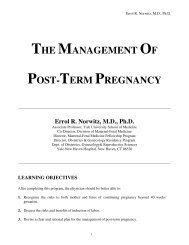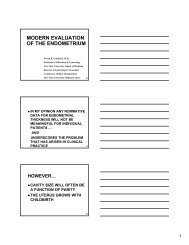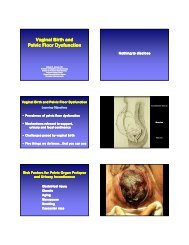Assisted Vaginal Delivery: A lost art? - neogs
Assisted Vaginal Delivery: A lost art? - neogs
Assisted Vaginal Delivery: A lost art? - neogs
Create successful ePaper yourself
Turn your PDF publications into a flip-book with our unique Google optimized e-Paper software.
<strong>Assisted</strong> <strong>Vaginal</strong><br />
<strong>Delivery</strong>:<br />
A <strong>lost</strong> <strong>art</strong>?<br />
Thomas F Baskett<br />
Dept Obstetrics and Gynaecology<br />
Dalhousie University<br />
Halifax, Nova Scotia<br />
1
USA. Nonfederal Hospitals: National Hospital<br />
Discharge Survey<br />
(Kozak, Weeks. Birth 2002;29:157)<br />
%<br />
1980<br />
1990<br />
2000<br />
Forceps<br />
17.7<br />
8.6<br />
4.0<br />
Vacuum<br />
0.7<br />
6.1<br />
8.4<br />
Caesarean<br />
16.5<br />
23.5<br />
22.9<br />
<strong>Assisted</strong> <strong>Vaginal</strong> <strong>Delivery</strong>: Canada<br />
1991 2001<br />
Forceps 11.2% 6.8%<br />
Vacuum 6.8% 10.6%<br />
2
Second Stage of Labour<br />
- Causes of Dystocia -<br />
POWERS<br />
PASSENGER<br />
PASSAGES<br />
Uterine*<br />
Maternal*<br />
Size<br />
Malposition*<br />
Malpresentation<br />
Anomaly<br />
Bony<br />
Soft tissue*<br />
Nullipara<br />
Vs<br />
Multipara<br />
“The dynamics of labour<br />
are more important<br />
than the mechanics”<br />
Ian Donald<br />
3
Utero – Fetal – Pelvic relationships<br />
Uterine work<br />
Maternal effort<br />
Fetal head - presentation<br />
- position<br />
- attitude (flexed/deflexed)<br />
- synclitism (anterior/posterior)<br />
- caput<br />
- moulding<br />
- station (cm)<br />
Bony pelvis<br />
Uterine work<br />
Second stage of labour: Nullipara<br />
No epidural Epidural<br />
Oxytocin 10.1 pg/ml 0 pg/ml<br />
increment<br />
Uterine activity 1623 1368<br />
(K pas/15 min)<br />
Goodfellow BJOG 1983;90:214<br />
Bates BJOG 1985;92: 1246<br />
4
Second stage of labour<br />
- Epidural –<br />
RCT: 226 Nullipara ± Oxytocin<br />
Oxytocin augmentation:<br />
↓ Duration<br />
↓ Pushing time<br />
↓ Forceps delivery<br />
Saunders et al BMJ 1989;229:1423<br />
“Good contractions are worth<br />
half an inch of true conjugate”<br />
Ian Donald<br />
Maternal effort<br />
2 phases of second stage of labour:<br />
• Passive →uterine work→descent to pelvic floor<br />
• Active →maternal effort→ delivery<br />
5
Maternal position<br />
Recumbent<br />
Upright<br />
Duration<br />
↓<br />
= <strong>Assisted</strong> delivery =<br />
= Epis / Tears =<br />
Worse<br />
Worse<br />
Worse<br />
Worse<br />
Blood loss<br />
Abnormal FHR<br />
Apgar score<br />
Cord pH<br />
Maternal choice<br />
↑<br />
Fetal head<br />
Position: transverse → anterior<br />
→ posterior (larger diameter)<br />
Attitude: flexed<br />
deflexed (larger diameter)<br />
Synclitism: anterior<br />
posterior (disproportion)<br />
Caput: subjective 1+ 2+ 3+<br />
6
Bony pelvis<br />
- Clinical pelvimetry-<br />
Diagonal conjugate<br />
Sacral bay<br />
Side walls<br />
Ischial spines<br />
Sacro-spinous ligs<br />
Subpubic arch<br />
Inter-tuberous diam<br />
≥ 12cm<br />
Curved<br />
Parallel<br />
Not prominent<br />
2 fingers (≥4cm)<br />
Not narrow<br />
≥ 10cm<br />
9
Full Cervical Dilatation<br />
Nature<br />
1 hour<br />
↓<br />
Oxytocin augmentation<br />
1 hour<br />
↓<br />
Maternal effort + Oxytocin<br />
1 hour<br />
↓<br />
Decision re delivery<br />
10
Indications for <strong>Assisted</strong> <strong>Vaginal</strong><br />
<strong>Delivery</strong><br />
Maternal:<br />
Fetal:<br />
Medical condition (↑ BP, cardiac)<br />
Fatigue<br />
Request<br />
Non-reassuring FHR/fetal distress<br />
Combination: Non-progressive labour<br />
- Nullipara: 3 hr with regional, 2 hr without<br />
- Multipara: 2 hr with regional, 1 hr without<br />
Classification of <strong>Assisted</strong> <strong>Vaginal</strong> <strong>Delivery</strong><br />
Mid<br />
O → + 1cm<br />
OA, OT, ≤ 45° OP > 45°<br />
Low<br />
≥ 2cm but not on pelvic floor<br />
OA, OT, ≤ 45° OP > 45°<br />
Outlet On pelvic floor<br />
Scalp visible without labial separation<br />
OA, OP < 45°<br />
ACOG Practice Bulliten No 17<br />
Obstet Gynecol 2000;95. No 6.<br />
11
Trial of <strong>Assisted</strong> <strong>Vaginal</strong> <strong>Delivery</strong><br />
‘It is a most comforting thought, when sitting<br />
down to do a mid-forceps operation, that one<br />
is not irrevocably committed to vaginal<br />
delivery’.<br />
Douglass & Kaltreider, 1953<br />
‘Failure to deliver with forceps is not so great<br />
a sin as failure to recognize defeat at an early<br />
stage’.<br />
Jeffcoate, 1953<br />
Achieve vaginal delivery<br />
Perineal trauma<br />
Pelvic floor function (5yr)<br />
Cephalhaematoma/Retinal<br />
haemorrhage<br />
Maternal worry<br />
5 min Apgar<br />
Forceps<br />
+<br />
+<br />
=<br />
=<br />
Vacuum<br />
=<br />
+<br />
+<br />
=<br />
Cochrane Database 2004<br />
Soft Vs Rigid Vacuum Cup<br />
9 trials. 1375 deliveries. Cochrane database, 2000<br />
Less likely to achieve OR 1.65 (1.19 – 2.29)<br />
vaginal delivery<br />
Less scalp injury OR 0.45 ( 0.15 – 0.60)<br />
12
‘The pneumatic tractor<br />
….seems peculiarly<br />
adapted to the purpose of<br />
obstetric surgery, viz, as<br />
a substitute for the steel<br />
forceps, in the hands of<br />
men who are deficient in<br />
manual dexterity,<br />
whether from<br />
inexperience or natural<br />
inaptitude’<br />
13
Cup Application<br />
Flexing Flexing Deflexing Deflexing<br />
median paramedian median paramedian<br />
Vacuum <strong>Delivery</strong><br />
- Traction -<br />
• 1 Pull = traction during one uterine<br />
contraction<br />
• Descent (pelvic) phase – 3 pulls<br />
• Outlet (perineal) phase – 3+ pulls<br />
• ‘Pop-offs’ – undesirable<br />
– careful reappraisal<br />
16
Vacuum <strong>Delivery</strong><br />
- Traction –<br />
• With uterine contraction and<br />
maternal effort<br />
• Finger-thumb position:<br />
- finger assesses ‘negative traction’<br />
- thumb → counter pressure<br />
• Two-finger pull on traction bar<br />
17
A prospective observational study of<br />
1000 vacuum assisted deliveries with<br />
the OmniCup device<br />
T.F. Baskett, C.A. Fanning,<br />
D.C. Young<br />
Dept. Obstetrics and<br />
Gynaecology<br />
Dalhousie University<br />
Halifax, Nova Scotia<br />
Method of <strong>Delivery</strong><br />
Vacuum<br />
Vacuum→forceps<br />
Vacuum→spontaneous<br />
Vacuum→forceps→C/S<br />
Vacuum→C/S<br />
No<br />
871<br />
98<br />
11<br />
10<br />
10<br />
(%)<br />
(87.1)<br />
(9.8)<br />
(1.1)<br />
(1.0)<br />
(1.0)<br />
Failure to deliver with Omnicup<br />
2% Vacca 2001<br />
4.8% (Vs soft 12.1%) Kar, UK.2005<br />
8.2% Senanake, UK 2006<br />
9.2% (Nullipara) Vacca 2006<br />
12.7% Hayman, UK. 2002<br />
30.1% (Vs 19.2% RCT) Groom, UK. 2006<br />
34.4% (Vs 21.4% RCT) Attilakos, UK. 2006<br />
12.9% Halifax, 2006<br />
18
Failed Vacuum <strong>Assisted</strong> <strong>Delivery</strong><br />
Women’s Hospital, Halifax<br />
Failed<br />
Vacuum → Forceps 134<br />
→ C/S 12<br />
→ Spontaneous 11<br />
→ Forceps → C/S 10<br />
Total 167<br />
No neonatal injury<br />
“I consider it derogatory to any liberal man<br />
to assume the office of a nurse, of an old<br />
woman: it is an imposture to pretend that a<br />
medical man is required at labour. Not only<br />
is is beneath our dignity, but it is not within<br />
our province. I do not consider the delivery<br />
of a woman as a surgical operation”.<br />
Sir Anthony Carlisle<br />
Address to select committee on medical education.<br />
British Parliament, 1834<br />
Bibliography<br />
Americian College of Obstetricians and Gynecologists.<br />
Practice Bulletin No. 17. Operative <strong>Vaginal</strong> <strong>Delivery</strong>. Obstet<br />
Gynecol 2000;95:6.<br />
Attilakos,G Sibanda T, Winter C, Johnson N, Draycott T. A<br />
randomised controlled trial of a new handheld vacuum<br />
extraction device. Br J Obstet Gynaecol 2005;112: 1510-15<br />
Baskett TF, Arulkumaran S (eds). Operative delivery and<br />
intrap<strong>art</strong>um surgery. Clin Obstet Gynaecol. London:Bailliere<br />
Tindal, 2002;16:pp131.<br />
Baskett TF, Non-progressive labour: Dystocia. In: Essential<br />
Management of Obstetric Emergencies. 4 th ed.,<br />
Bristol: Clinical Press, 2004. 119-133.<br />
19
Baskett TF, Calder AA, Arulkumaran S. <strong>Assisted</strong> vaginal<br />
delivery. In: Munro Kerr’s Operative Obstetrics, 11 th<br />
Centenary Edition. Edinburgh: Elsevier, 2007.pp 91-125.<br />
Bates RG, Helm CW, Duncan A, Edwards DK. Uterine<br />
activity in the second stage of labour and the effect of<br />
epidural analgesia. Br J Obstet Gynaecol 1985;92: 1246-<br />
50.<br />
Bird GC, Importance of flexion in vacuum delivery. Br J<br />
Obstet Gynaecol 1976;83: 194-200.<br />
Goodfellow CF, Howell mg, Swaab DF. Oxytocin<br />
deficiency at delivery with epidural analgesia. Br J Obstet<br />
Gynaecol 1983;90 214-219.<br />
Groom KM, Jones BM, Miller N, Patterson-Brown<br />
S. A prospective randomised controlled trial of the<br />
Kiwi OmniCup versus conventional cups for<br />
vacuum-assisted vaginal deloivery. Br J Obstet<br />
Gynaecol 2006;113: 183-9.<br />
Hanson SL, Clarke SL, Foster JC. Active pushing<br />
versus passive fetal descent in the second stage of<br />
labor-a randomised controlled trial. Obstet Gynecol<br />
2002;99:29-34.<br />
Jong, PR, Johanson RB, Backson P et al.<br />
Randomized trial of comparing the upright and<br />
supine positions for the second stage of labour. Br J<br />
Obstet Gynaecol 1997;104:567-71.<br />
Royal College of Obstetricians and Gynaecologists.<br />
Instrumental <strong>Vaginal</strong> <strong>Delivery</strong>. Guideline No. 26;<br />
London: RCOG, 2005.<br />
Saunders NJ, Spiby H, Gilbert L. Oxytocin infusion<br />
during 2 nd stage of labour in primiparous women using<br />
epidural analgesia: a randomized double-blind placebocontrolled<br />
trial. BMJ 1989;299: 1423-26.<br />
Society of Obstetricians and Gynaecologists of Canada.<br />
Guidelines for <strong>Vaginal</strong> Birth. Clinical Practice Guidelines<br />
No. 148. J Obstet Gynaecol Can 2004;26:747-53.<br />
Vacca A. Handbook of Vacuum <strong>Delivery</strong> in Obstetric<br />
Practice. 2 nd ed. Brisbane: Vacca Research, 2003.<br />
20
USA/Canada Training Programmes<br />
OUTLET:<br />
LOW (45°):<br />
MID:<br />
Forceps<br />
Vacuum<br />
Forceps<br />
Vacuum<br />
Forceps<br />
Vacuum<br />
Forceps<br />
Vacuum<br />
Resident<br />
100<br />
100<br />
92<br />
92<br />
80<br />
82<br />
38<br />
47<br />
Fellow<br />
100<br />
100<br />
92<br />
92<br />
76<br />
80<br />
69<br />
73<br />
Hankins et al<br />
Am J Perinatol<br />
1999;16:23<br />
21






